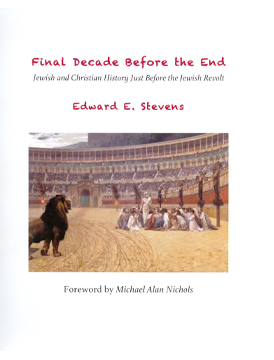One Column Page
and responsive to boot
Mop-up Operations After Jerusalem Fell
by Edward E. Stevens
This article appeared in the 2023 Fall issue of Fulfilled! Magazine

Our two previous articles gave us a peek into the desperate situation in Jerusalem during the siege. It was a literal horror story, which clearly shows what happens to a nation which fails to honor God and serve Him. God abandons them to be destroyed by those who are even more wicked.
Christians around the world desperately need to remember this lesson of history. We need to humble ourselves and pray and seek His face and turn from our wicked ways so that He will draw near to us again and heal our land (2 Chron 7:13-14).
In the previous article, we ended with the burning of the Temple and the complete subjugation of Jerusalem by September 7, AD 70. Only three fortresses remained under the control of the Zealots—Herodium, Machaerus, and Masada. The following is a chronology of the mop-up operations after the fall of Jerusalem.
AD 70 – Simon b. Giora and John of Gischala (two of the three main Zealot leaders) came out of their underground hiding places and surrendered to the Romans. Titus held them in chains to take them to Rome to be displayed in his triumphal celebration. Simon bar Giora was executed at the end of the triumph “by being thrown to his death from the Tarpeian Rock near the Temple of Jupiter” (Wikipedia article entitled, Simon bar Giora). John of Gischala was imprisoned in chains in Rome for the rest of his life [Wars 6.433-434 (6.9.4)].
AD 70 – “Not one stone left upon another” (Matt 24:2) – After Jerusalem fell, the Roman soldiers dismantled the Temple stone by stone to get the gold and silver out from between the cracks where it had melted during the fire, thus unknowingly fulfilling Jesus’ prophecy about not one stone left standing upon another [Wars 7.1-3 (7.1.1); 7.115 (7.5.2); 7:376 (7.8.7)]. Of course, Jesus was referring only to the temple building itself, not to the outer perimeter walls of the temple platform, but most futurists miss this point.
Oct 70 – The temple vessels were taken to Rome by Titus (Wars 7:5:5-7). Many of the young healthy captives were taken to Rome. The children were sold as slaves. The old and sick were killed. Seven hundred were reserved by Titus for his triumph in Rome, including both Simon b. Giora and John of Gischala. The rest of the able-bodied were sent to the mines, rock quarries, galley ships, and to various Roman cities to be used in their theatres and arenas for amusement, and to fight with wild animals [Wars 1:28 (20.11.3); 2:457 (2.18.1); 6:418 (6.9.2); 7:24 (7.2.1); 7:38 (7.3.1); 7:208 (7.6.4); 7:373 (7.8.7)]. Earlier in the war (AD 67), Vespasian sent six thousand captives to Corinth to help dig the Isthmian canal [Wars 3:540 (3.10.10)].
Oct 70 – Josephus went to Rome with Titus, and was adopted into the Flavian family, and commissioned to write both the Wars (AD 78) and the Antiquities (AD 93). Agrippa II and his sister Bernice also went to Rome with Titus. Josephus supposedly obtained a lot of details about the war from Agrippa, which were added to his Wars and Antiquities (according to Schurer and Glatzer).
Oct 70 – Yohanan b. Zakkai – Shortly before Vespasian was proclaimed emperor (AD 69), Yohanan b. Zakkai, the most prestigious Pharisaic rabbi at that time, defected to the Romans. He was associated with the school of Gamaliel I, the same school where Saul of Tarsus had studied one generation earlier. When brought before Vespasian, he predicted that Vespasian would soon become Emperor and capture Jerusalem. He only asked that he be allowed to build a school at Yavneh. But he did far more than just build a school. Those rabbis secretly reconstituted the Beit Din (house of judgment, i.e., Sanhedrin council), ostensibly only for deciding matters related to Jewish customs, culture, and religion, but later found to be fostering the second Bar Kokhba revolt sixty-two years later. It was this group of rabbis who transformed Biblical Judaism into Rabbinic (or Talmudic) Judaism. Yohanan was the chief rabbi who later tutored Rabbi Akiba, who sixty years later proclaimed Bar Kokhba as the Messiah. That group of rabbis made the most sweeping changes in Jewish doctrine and practice for all generations to come. They developed a new kind of Judaism that did not need the Temple, priesthood, or sacrifices. They finalized the Old Testament canon of Scripture, and formulated the 18 benedictions, to which they soon added a severe malediction (curse) against heretics (minim). That malediction was also aimed at the Judaizing false Christians who were left behind. There were no writings coming from any true Christians at this time claiming that the Christians were the True Jews and True Sons of God. This makes us wonder what happened to the Christians who supposedly fled to Pella and other areas outside Judea before the war. If they were still around, why were they so silent?
Three Fortresses Remained
AD 70 – Vespasian ordered Lucilius Bassus (military commander) and Liberius Maximus (the new procurator) to sell all the land in Judea. He gave the city of Emmaus to 800 of his soldiers for them to inhabit after he honorably dismissed them from their military service. He also imposed a two-drachma tax on every Jew, which is the same amount they formerly paid every year to the Temple in Jerusalem. [Wars 7:216-218 (7.6.6)]
AD 71 – Three fortresses remained in the hands of the Zealots—Herodium, Machaerus, and Masada. Bassus was sent to eliminate those three fortresses. He assumed control of the troops from Cerealis Vitellius, and marched to Herodium. Its defenders quickly capitulated with little resistance [Wars 7.163 (7.6.1)].
AD 72 – Machaerus was better situated and supplied, and thus put up more resistance. It was originally fortified by Alexander Janneus in about 90 BC. It was subsequently destroyed by Pompey’s General Gabinius (57 BC), but then rebuilt by Herod the Great in 30 BC [Wars 7.171-177 (7.6.2)]. After Herod died, it was given to his son Herod Antipas (who ruled 4 BC until AD 39). This is where Antipas imprisoned John the Baptist and then beheaded him at the request of his wife Herodias’s daughter Salome (Matt 14:1-12) [Antiq 18.116-119 18.5.2]. Bassus took his army to Machaerus and built a ramp on the east side from which to more easily batter its walls and storm the fortress. The Jews in the upper city quickly surrendered when one of their young defenders was captured and threatened with crucifixion. A few within the lower city were able to escape, but 1,700 of the remaining men were killed, while their women and children were sold as slaves [Wars 7.164-209 (7.6.1-4)].
AD 72 – Judas b. Jairus (Yair) and some others had escaped from Jerusalem during the siege through some underground tunnels and fled to the forest along the Jordan river, where they were joined by the refugees from Machaerus. Bassus then sent his scouts to find them, and brought his cavalry to surround their camp. The soldiers cleared the trees around the site to prevent their escape. This forced the Jews out in the open. Only twelve Roman soldiers were killed and a few more wounded, while all 3,000 of the Jews were killed. [Wars 7:210-215 (7.6.5)]
AD 72 – Lucilius Bassus died not long after Machaerus was captured and was replaced by General Flavius Silva, who then took charge of the assault on Masada. [Wars 7:252 (7.8.1)]
Refugees and Rebels fled to other nations and tried to rekindle the rebellion there
AD 73 – After Jerusalem fell, some of the Sicarii fled to Alexandria (Egypt) and tried to stir up a rebellion there. But the Jewish leaders in Alexandria took swift action against them and captured 600 of them. None of them were willing to desist from their rebellion or swear allegiance to Caesar, not even their wives and children, so they were put to death [Wars 7.413-419 (7.10.1)].
AD 73 – Other Rebels fled to Cyrene (Libya) where they tried to stir up trouble. One of them, named Jonathan, gathered a band of followers and led them into the desert, promising that he would perform miracles for them. The rulers of Cyrene reported this to the Roman governor Catullus, who sent horsemen and footmen out into the desert to round them up. When Jonathan was captured, he falsely claimed that the wealthy Jews of Cyrene had supported his efforts. Catullus then killed 3,000 of the leading Jews in Cyrene and seized their property. Jonathan then accused Josephus and some of the leading Jews of Alexandria of supporting his rebellion, but Vespasian found the accusation to be false. Jonathan was then tortured and burned alive, and Catullus was reprimanded by Vespasian for wrongly killing three thousand of the leading Jews in Cyrene. Soon afterwards, Catullus died of a severe intestinal disease, which the Jews considered to be his just punishment for killing their fellow countrymen [Wars 7.437-453 (7.11.1-4)].
Next time we will deal with the capture of Masada. For more details on any of this, check out our podcasts (www.buzzsprout.com/11633), and get a copy of my historical book, Final Decade Before the End, found here: www.preterist.org/product-cat/all/
Comments:
Your honest review will help others in their search for truth. If you must leave a negative review please be gracious.
Rather, speaking the truth in love, we are to grow up in every way into him who the head, into Christ . . . .
(Ephesians 4:15)
We have migrated to "Disqus" commenting software. Older comments (if any) are archived below, but any new comments on this page will be handled by Disqus. If you are not familiar with "Disqus," click here for more information. You don't need a Disqus account to post comments, however, without an account you won't be notified if someone responds to your post.
Archived Comments:
 Fulfilled
Fulfilled